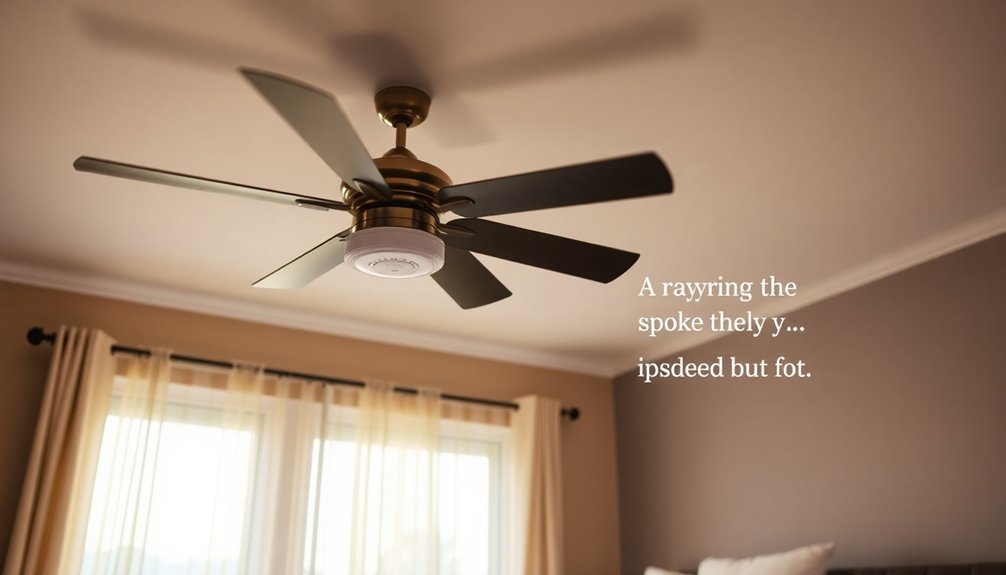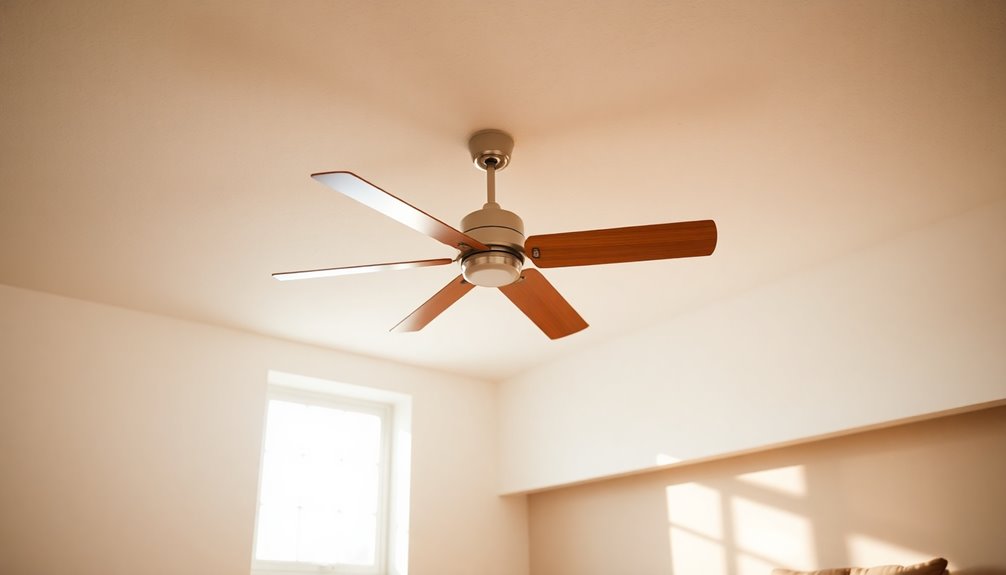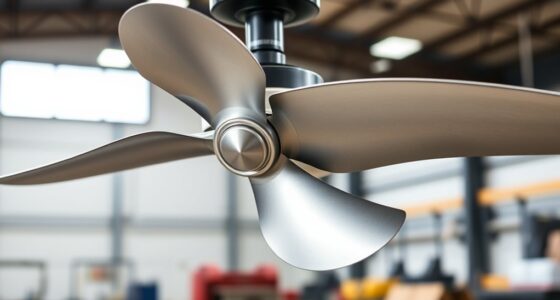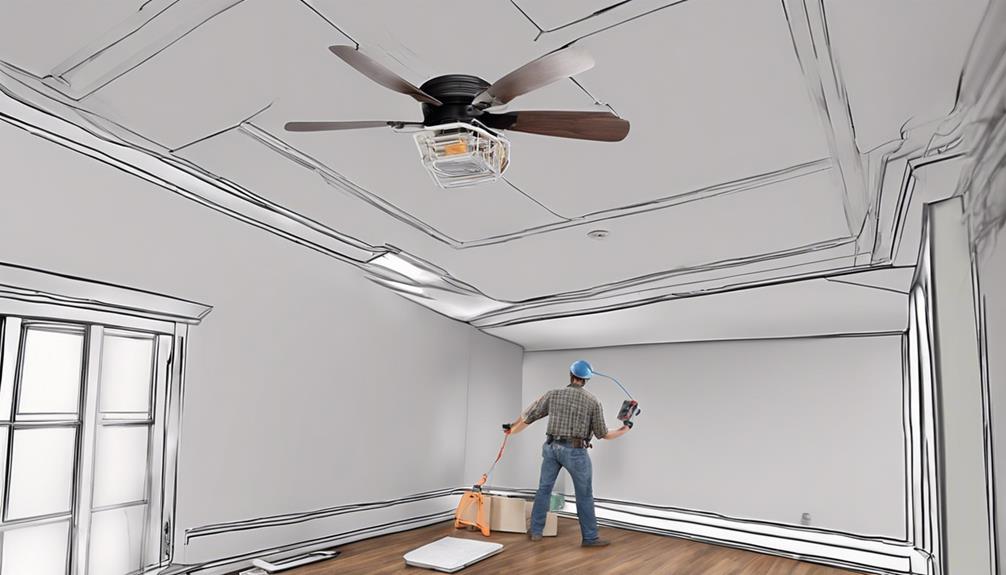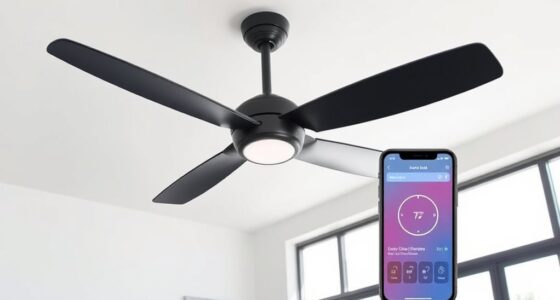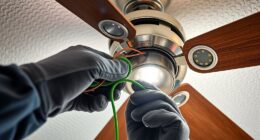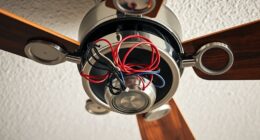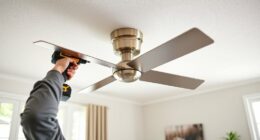You should install your smoke detector in the center of your bedroom ceiling, ensuring it's at least three feet away from the ceiling fan blades to prevent airflow interference. This placement helps the detector sense smoke more effectively. If you opt for wall-mounted detectors, keep them 4-12 inches from the ceiling. Avoid corners, as smoke lingers there and can hinder activation. Don't forget to test your alarm monthly and maintain it for best performance. For additional tips on choosing the right type of detector and mastering placement, just explore further.
Key Takeaways
- Install the smoke detector on the ceiling, ideally in the room's center, for maximum coverage.
- Keep the detector at least three feet away from ceiling fan blades to prevent airflow interference.
- Position it 4-12 inches away from the ceiling if wall-mounted, for optimal smoke detection.
- Maintain a distance of 1.5 meters (4 feet) from fan-forced vents to reduce false alarms.
- Ensure the smoke detector is within 21 feet of any point in the room for effective coverage.
Importance of Smoke Detectors

When it comes to fire safety, having smoke detectors in your home is essential. These devices are critical for early smoke detection, giving you and your loved ones the time needed to evacuate safely. The National Fire Protection Association (NFPA) emphasizes that smoke detectors should be installed in every area of your home, including bedrooms, to guarantee thorough fire safety.
By installing smoke detectors, you greatly lower the risk of fire-related fatalities and property damage. Studies show that homes with functioning smoke detectors can reduce the risk of death in a fire by an impressive 55%. This statistic underlines their key role in protecting you and your family.
However, simply having smoke detectors installed isn't enough. Regular maintenance, like testing and changing batteries, is essential for making sure they operate effectively when needed.
This proactive approach not only enhances your fire safety but also provides peace of mind, knowing you're prepared in case of an emergency. Remember, the key to maximizing the benefits of smoke detectors lies in proper installation and ongoing maintenance, so don't overlook these important steps.
NFPA Recommendations for Placement

To guarantee your smoke detectors work effectively, you need to follow the NFPA's recommendations for placement. The NFPA suggests installing your smoke detector on the ceiling, ideally at the center of the room. This location guarantees ideal smoke detection, especially in bedrooms with ceiling fans. However, you'll want to position the detector at least three feet away from the fan blades. This distance prevents airflow interference that could delay smoke detection.
Additionally, make certain to mount your smoke detector at least 60 cm (2 feet) from walls. This spacing avoids smoke lingering in corners, which could also hinder timely alerts.
It's also crucial to install the smoke alarm 1.5 m (4 feet) away from any fan-forced vents. This reduces the risk of false alarms and guarantees the detector functions properly.
Lastly, don't forget to adhere to local codes and regulations regarding smoke detector placement. They might've additional requirements beyond the NFPA guidelines.
Following these recommendations will help keep you safe and guarantee your smoke detector responds effectively when it matters most.
Ideal Locations for Installation

When it comes to installing smoke detectors in your bedroom, knowing the ideal locations is essential.
You'll want to take into account ceiling placement guidelines, wall mounting options, and the types of smoke detectors available to guarantee maximum safety.
Proper positioning can make all the difference in how quickly you detect smoke and respond to potential dangers.
Ceiling Placement Guidelines
Installing smoke detectors on the ceiling is essential for guaranteeing ideal safety in your bedroom. Following ceiling placement guidelines can make a significant difference in your home's safety. The NFPA recommends that you position your smoke detector at least three feet away from ceiling fan blades to prevent airflow interference, which can delay smoke detection.
For maximum effectiveness, mount the smoke detector close to the center of the room, as smoke rises and spreads outward. Additionally, verify the detector is at least 60 cm (2 feet) away from walls to avoid dead air spaces where smoke might linger.
Here's a quick reference table to help visualize ideal placement:
| Placement Guidelines | Description |
|---|---|
| Distance from Ceiling Fan | At least 3 feet away |
| Center of the Room | Close to the center for maximum detection |
| Distance from Walls | At least 60 cm (2 feet) away from walls |
| Alternative Placement | 4-12 inches from ceiling if wall-mounted |
| Regular Maintenance | Test and maintain detectors regularly |
Wall Mounting Considerations
Choosing the right location for wall mounting a smoke detector can greatly enhance safety in your bedroom. When you're dealing with a ceiling fan, you'll want to mount the detector 4-12 inches from the ceiling to guarantee effective smoke detection. This height helps avoid disruptions caused by airflow from the fan.
Additionally, it's vital to place the smoke detector at least three feet away from the fan blades, minimizing the risk of false alarms. Aim for detector placement near the center of the wall for ideal performance, but keep it clear of forced air vents by at least three feet.
Wall mounting is particularly beneficial if you have limited ceiling space or if the fan may hinder the detector's effectiveness.
Don't forget that regular testing and maintenance of your wall-mounted smoke detector are essential. This guarantees reliable operation, especially in bedrooms where airflow from ceiling fans can impact the detector's response.
Smoke Detector Types
Understanding the different types of smoke detectors can help you make informed decisions about where to install them in your bedroom. The National Fire Protection Association (NFPA) offers guidelines that can enhance your safety, especially when you have ceiling fans. Here are a few types to take into account:
- Ionization Smoke Alarms: Best for detecting fast-flaming fires, but may not respond as quickly to smoldering fires.
- Photoelectric Smoke Detectors: Highly recommended for bedrooms with ceiling fans, these are effective at detecting smoldering fires, which can start unnoticed while you sleep.
- Combination Alarms: These smoke alarms combine both ionization and photoelectric technologies, providing thorough protection for various fire types.
- Smart Smoke Detectors: These can send alerts to your phone and integrate with other smart home devices, guaranteeing you're always informed.
To comply with NFPA guidelines, install smoke detectors at least three feet away from ceiling fan blades. If ceiling installation isn't possible, mount them 4-12 inches below the ceiling.
Regular testing and maintenance are essential for all smoke detectors to verify they work effectively in emergencies.
Factors for Optimal Placement

When installing a smoke detector, ceiling placement is key for ideal detection, so aim for the center of the room.
Remember to keep it at least three feet away from any ceiling fans and vents to avoid interference.
If wall mounting, be mindful of the height and distance from potential airflow sources to guarantee reliable performance.
Ceiling Placement Guidelines
How can you confirm your smoke detector is ideally placed for effective monitoring? To guarantee optimal performance, follow these ceiling placement guidelines:
- Center the Detector: Install a smoke detector on the ceiling, ideally at the center of the room. This maximizes detection coverage.
- Maintain Distance from Ceiling Fans: Keep the detector at least three feet away from ceiling fan blades to prevent airflow interference that could hinder smoke detection.
- Clearance from Walls: According to NFPA 72, maintain a clearance of at least 60 cm (2 feet) from walls to avoid false alarms caused by airflow dynamics.
- Proximity to Bedroom Door: Position the smoke detector close to the bedroom door for early alerts during emergencies, while adhering to local codes and regulations.
If you have a larger bedroom, consider installing additional detectors to enhance coverage.
Regularly testing and maintaining your smoke detectors is essential, as it guarantees reliable operation and timely alerts in the event of a fire.
Wall Mounting Considerations
Wall mounting a smoke detector can be a practical solution for bedrooms, especially when ceiling installation isn't possible. When you choose to wall mount, position the smoke detector 4-12 inches from the ceiling to optimize its detection capabilities.
It's essential to keep the detector away from the direct airflow of your ceiling fan; ideally, it should be at least three feet from the fan blades. This prevents airflow interference that could delay smoke detection.
For the best results, mount the smoke detector near the corner of the room, about 2-3 feet from the walls. This placement enhances detection while minimizing the chances of false alarms caused by airflow dynamics.
Make sure the installation keeps the detector within 21 feet of any point in the room to guarantee effective smoke coverage.
Lastly, don't forget that regular testing and maintenance of wall-mounted detectors are important. This guarantees they function properly and provide timely alerts during emergencies, giving you peace of mind in your bedroom.
Choosing the Right Detector Type

Choosing the right smoke detector type is vital for guaranteeing safety in your bedroom.
With a ceiling fan influencing airflow patterns, it's important to select a detector that minimizes false alarms while effectively detecting fires. Here are some options to take into account:
- Photoelectric smoke detectors: These are recommended for bedrooms with ceiling fans, as they excel at detecting smoldering fires, which are often more common in sleeping areas.
- Ionization smoke detectors: Although they respond quicker to fast-burning fires, they can trigger false alarms in rooms with airflow disruptions caused by ceiling fans.
- Dual-sensor smoke detectors: Combining both ionization and photoelectric technologies, these detectors offer extensive coverage for various fire types, making them a versatile choice.
- Regular testing: Whichever type you choose, make certain to test your smoke detector monthly to confirm it's functioning properly during emergencies.
Common Placement Mistakes

When it comes to smoke detector placement, many homeowners make critical mistakes that can compromise safety. One common mistake is placing the smoke detector too close to a ceiling fan. To avoid airflow interference that can delay smoke detection, make sure it's at least three feet away.
Additionally, installing a smoke detector in the corners of the room can lead to poor performance. Smoke tends to linger in corners, making it harder for alarms to activate.
Another oversight is failing to take into account the location of supply and return vents. If you position detectors in direct airflow, you might experience false alarms or hinder detection capabilities.
It's also essential not to neglect larger bedrooms. You may need more than one smoke detector to guarantee thorough coverage.
Lastly, if you're opting for wall-mounted detectors, avoid mispositioning them. They should be installed 4 to 12 inches from the ceiling to optimize effectiveness without obstructing airflow.
Impact of Ceiling Fans

Ceiling fans can greatly affect the performance of smoke detectors, particularly in bedrooms where airflow is essential. The movement of air caused by ceiling fans can hinder smoke detection, delaying your smoke detector's response times during emergencies.
To guarantee your smoke detector works effectively, consider these important points:
- Distance: Install smoke detectors at least three feet away from ceiling fan blades to avoid airflow interference.
- Speed Settings: Operating your ceiling fan at lower speeds can help improve smoke detector function and reduce false alarms.
- Placement: Avoid placing smoke detectors directly beneath ceiling fans, as the airflow can disperse smoke particles away from the detector.
- NFPA Guidelines: Adhere to NFPA recommendations, which suggest positioning smoke detectors away from forced air systems for peak performance.
Maintenance and Testing Guidelines

To guarantee your smoke detector operates effectively, regular maintenance and testing are essential. Start by following the manufacturers instructions and test your smoke detector at least once a month. Simply press the test button to verify it's functioning properly. If you hear a beeping sound, that's a clear sign to change the batteries immediately, or at least once a year to prevent any unexpected failures.
Every six months, take the time to clean your smoke detector. Dust and debris can accumulate and impair its function, so a quick wipe-down helps maintain its efficiency.
Remember that smoke detectors aren't meant to last forever; replace them every 10 years. Their sensitivity can diminish over time, which could lead to reduced effectiveness in an emergency.
To keep track of these important tasks, maintain a log of testing dates and battery changes. This not only helps you stay organized but also aligns with NFPA guidelines for fire safety.
Additional Safety Considerations

In addition to regular maintenance, several safety considerations can enhance the effectiveness of your smoke detectors in the bedroom. By implementing the following guidelines, you can guarantee your smoke alarm operates at peak performance, especially in rooms with ceiling fans.
- Placement: Install the smoke detector at least three feet away from ceiling fan blades to prevent airflow interference, which could delay smoke detection.
- Height: Position the smoke detector on the ceiling or high on a wall, ideally within 4-12 inches from the ceiling, to maximize its ability to detect rising smoke.
- Type: Choose photoelectric smoke detectors for bedrooms with ceiling fans. They're less likely to trigger false alarms due to airflow disturbances compared to ionization detectors.
- Accessibility: Keep the area around the smoke detector clear, avoiding obstructions from furniture or decorations, guaranteeing it can effectively sense smoke in the room.
Frequently Asked Questions
Where Should Smoke Detectors Be Placed in Bedroom With Ceiling Fan?
You should place smoke detectors in your bedroom to maximize safety.
Ideally, install them on the ceiling, at least three feet away from the ceiling fan blades to avoid airflow interference. If that's not possible, mount them on the wall, 4-12 inches below the ceiling.
Position the detector near the center of the room for better detection. In larger bedrooms, consider multiple detectors for thorough coverage.
Don't forget to regularly test and maintain them!
Where Is the Best Place to Put a Smoke Detector in a Bedroom?
The best place to put a smoke detector in your bedroom is on the ceiling, ideally at least three feet away from any walls or ceiling fans to prevent airflow issues.
If ceiling installation isn't possible, mount it on the wall, keeping it 4-12 inches below the ceiling.
Position it near the center of the room for maximum effectiveness.
Don't forget to test it monthly and replace the batteries annually to guarantee it works properly.
How Far Should a Smoke Detector Be From a Bedroom?
Imagine a silent night, where every second counts.
When it comes to smoke detectors, you should install them at least three feet away from your bedroom. This distance guarantees they detect smoke quickly without interference from nearby airflow sources.
If possible, place them on the ceiling, ideally in the room's center.
Will a Ceiling Fan Affect a Smoke Detector?
Yes, a ceiling fan can affect a smoke detector's performance.
The airflow generated by the fan can disperse smoke, making it harder for the detector to sense it quickly.
To guarantee reliable smoke detection, you should keep the detector at least three feet away from the fan blades.
Additionally, using the fan on a lower speed can help smoke rise and reach the detector more effectively during an emergency.
Conclusion
In conclusion, installing a smoke detector in your bedroom is essential for your safety, especially if you have a ceiling fan. Keep it at least 10 feet away from the fan to avoid false alarms while ensuring it's easily accessible for maintenance. Remember, a stitch in time saves nine; regular testing and upkeep can make all the difference. Stay proactive, and you'll sleep better knowing you've taken the right steps to protect yourself and your loved ones.
